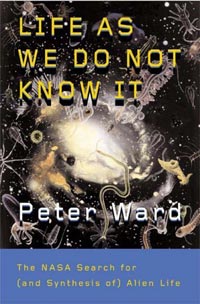Review: Life as We Do Not Know Itby Jeff Foust
|
| After all, if something is life “not as we know it”, how, in fact, would we know it to be life at all? |
Ward is famous—or perhaps infamous—for the 2000 book Rare Earth, where he and UW colleague Donald Brownlee argued that while simple microbial life might be commonplace in the universe, complex life (including intelligent life) would be highly uncommon. This conclusion raised the ire of many supporters of the search for extraterrestrial intelligence (SETI), which Ward says, “like the science fiction industry, depends on a belief in aliens for its economic viability.” Some critics of that book pointed out that its conclusions were based on the assumption that life must be “Earthlike” and thus can only be supported on relatively rare Earthlike planets. What if there were different types of life that could find niches on worlds not at all similar to the Earth?
While Ward is still a SETI skeptic (he recalls with a bit of glee a chance encounter with SETI astronomer Jill Tartar at the home of Microsoft cofounder Paul Allen) he is certainly open to the possibility that life beyond Earth need not look anything like life on Earth. Indeed, in the first part of Life as We Do Not Know It Ward makes the case that “alien” life—life that is not based on two-stranded DNA and twenty amino acids—may in fact exist on Earth itself, either in hidden niches deep in the oceans and beneath the surface, or in the laboratories of biochemists. Ward argues that such alien life has already been discovered and is familiar to most everyone: viruses, which most conventional biologists do not consider to be living since they cannot reproduce on their own. (Ward admits that his point of view is “heretical” but shared by some other scientists.)
Understanding the various alternative forms that life can take on, including using ammonia in place of water or (less likely) silicon in place of carbon, leads Ward to the second half of the book, where he tours the solar system in search of potential abodes of life. These range from the upper atmosphere of Venus to the subsurface of Mars, as well as the oceans below Europa’s icy crust and Titan’s cold but organics-rich surface. Ward is particularly optimistic about Mars, noting the detections of methane in that planet’s atmosphere, and Titan, where hotspots below the surface could nurture life of some kind. He is less optimistic about Europa, which he believes is too cold for Earthlike life and “not weird enough” to support the formation of alien life.
| The search for life, familiar or bizarre, elsewhere in the solar system may yet become one of the more compelling rationales for human space exploration: life searching for life. |
In just over 250 pages of text (plus an extensive references section), Ward does an admirable job offering facts and opinions on the subject of astrobiology and the question of what, exactly, is life. There are a few nits to pick, such as some minor but consistent spelling errors (“Alan Hills” instead of “Allan Hills”, the source of Martian meteorite ALH 84001, and “Cal Tech” instead of “Caltech”). Many of the people mentioned in the book are colleagues of Ward at UW: Ward is director of the UW “node” of the NASA Astrobiology Institute and administers a five-year grant that NASA awarded the university in 2001, and he admits early on in the book that he will frequently refer to his colleagues’ work throughout the text. Finally, while astrobiology is a rapidly-evolving field of research—he states that the “astonishing rush” of discovery has rendered obsolete many books on the subject, even those published in the last five years—Life as We Do Not Know It has a slightly stale feel to it: although officially published in November 2005, there is little discussion of, as one example, the results of the Huygens probe that landed on Titan in January. And in the acknowledgments section Ward thanks several NASA officials, including “its administrator, Sean O’Keefe”, even though O’Keefe announced his resignation a year ago and left the space agency in early 2005.
For those used to reading about planetary science or space exploration—especially those who have not studied biology since high school or college—the first half of Life as We Do Not Know It may be a bit of a hard slog, as Ward introduces some molecular biology concepts to the reader as part of the discussion of what is life and how life might differ from what is known on the Earth. However, the result is rewarding in more ways than one. Not only does Ward offer some eye-opening insights into the concept of life and how it might take hold elsewhere in the solar system, it turns out he is an advocate of human space exploration to search for such life. Ward admits that his conversion to a human spaceflight proponent is new: “Even a year ago I would certainly have protested such a proposal.” However, he argues that only humans have the skills to look for rock fragments on the surface of the Moon that may be detritus from the Earth, Mars, or Venus that could offer insights into their early histories and potential for life; look for fossils on Mars; or even search for life of some sort on Titan. His case for sending a paleontologist to Mars is strong, although not that novel (others, such as Robert Zubrin, have long argued that humans are much better suited for looking for fossils than even the most advanced robotic rovers); the reverse is true for Titan. Nonetheless, the search for life, familiar or bizarre, elsewhere in the solar system may yet become one of the more compelling rationales for human space exploration: life searching for life.
